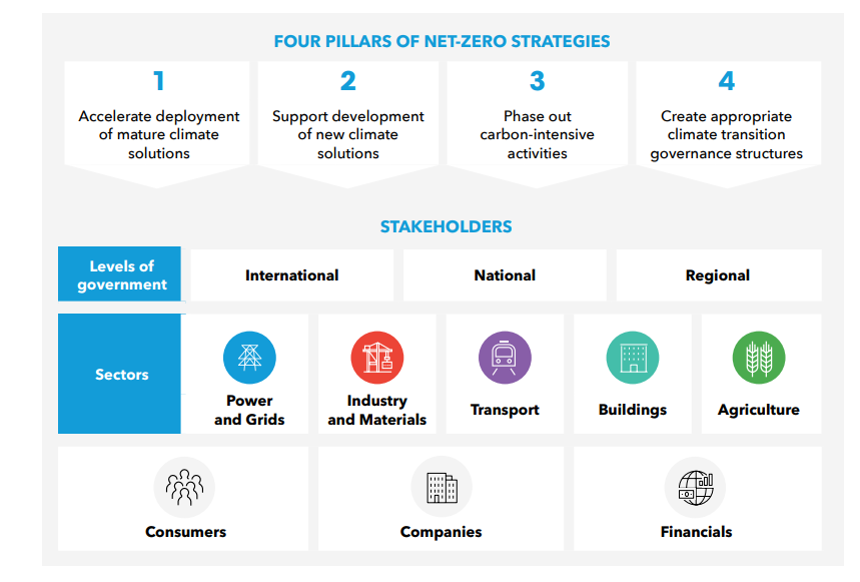Sign up for daily news updates from CleanTechnica on email. Or follow us on Google News!
BloombergNEF’s (BNEF’s) new policy blueprint, the NetZero Pathfinders framework, has been designed to help governments and other stakeholders to devise and implement the best net zero trajectory programs for their markets. The framework helps to make transparent the various policy actions that can build together to achieve the goals of the Paris Climate agreement. It tackles the complexities of net zero policy decision-making — from accelerating the deployment of mature and emerging cleantech to phasing out carbon-intensive activities, including actionable solutions and best practices.
During a webinar on September 12, 2024, BNEF launched the new public platform and shared analysis from the policy framework. The facilitators, with host Emma Champion, head of BNEF’s regional energy transitions, discussed what makes good clean energy policies, followed by a Q&A.
Why is a NetZero Pathfinders Framework Needed?
Economics cannot be the sole measure toward achieving the goals of the Paris agreement. Global emissions goal reductions by 2050 require accelerated policy support, which, while achievable, “will be tough,” according to Victoria Cuming, BNEF’s head of global policy. Designing an effective policy mix is no easy feat, with various mechanisms needed to suit different technologies, sectors, and geographies.
Robust emissions reductions will require much more green investment and government policy support.
The BNEF platform outlines how sectors can decarbonize and how policy actions can be implemented successfully. They consulted analysts all over the world, their various databases, and regular publications to achieve what Cuming called “symbiosis” among different resources. The framework is meant to be a resource of all the net zero policy measures so that governments can analyze where their highest emissions are and prioritize their needs.
Four Pillars of Net Zero Policy Support
Thematic pathfinders help policy holders and other stakeholders to drive down emissions. To assist navigation through potential policy paths to net zero policy, the Pathfinders actions are split into four pillars.
Pillar 1 — Accelerate deployment of mature climate solutions: Thanks to extraordinary progress achieved over the past decade, technologies that emit zero carbon dioxide already exist and are increasingly cost-competitive with their fossil-fueled rivals. This list includes wind and solar power projects in most of the world and electrified vehicles in a small but growing number of markets. Yet these climate-friendly technologies do not always flourish, in part due to policies that explicitly protect incumbents.
Pillar 2 — Support development of new climate solutions: To zero out emissions entirely, more clean energy technologies will be required to provide around-the-clock, zero-carbon power; decarbonize industrial processes; cut emissions associated with livestock and agriculture; and meet other challenges.
Pillar 3 –Phase out carbon-intensive activities: Despite the immediate threat posed by climate change, governments continue to subsidize fossil fuel production and consumption – whether directly or through state-owned companies and financial institutions. While such support should be phased out, scaling back subsidies that artificially cap consumer energy prices can be politically challenging. Nonetheless, policymakers and others have found innovative ways to phase out support for fossil fuels.
Pillar 4 — Create appropriate climate transition governance structures: The scope of the climate crisis is forcing governments to take a multi-decadal view of the problem. But policies are only as good as the frameworks to devise, implement, and enforce them. Policymakers must recognize that attracting investment in low-carbon technologies — and enjoying the associated economic benefits — requires constructing governance structures that are durable and long-lasting.

 Chip in a few dollars a month to help support independent cleantech coverage that helps to accelerate the cleantech revolution!
Chip in a few dollars a month to help support independent cleantech coverage that helps to accelerate the cleantech revolution!
Examples of Net Zero Policy Approaches
Brynne Mary Merkley, BNEF energy transitions associate, described some approaches within the Pillars to accelerate deployment of mature climate solutions.
Promoting consumer incentives for heat pumps and efficiency measures in France has been well-received.
Penalties for fossil fuel heating can accelerate deployment of mature climate solutions.
Increased demand-side flexibility as well as low carbon thermal capacity — such as gas power plants abated with carbon capture and storage, or plants running on zero-carbon hydrogen — become important aspects of the power sector’s transition.
Operational subsidies can support the additional cost of producing low carbon technologies and materials. In markets with (or planning to introduce) a carbon pricing mechanism, CO2 contracts for difference can effectively reduce the subsidy bill for governments through carbon market revenues.
The EU’s Emission Trading System — which requires polluters to pay for their greenhouse gas (GHG) emissions — is an example of careful net zero policy design.
Economy standards are efficient climate actions, as they are good drivers of decarbonization — yet they need to be tightened over time. One example is the CO2 performance standards, which point to the eventual elimination of ICE vehicles.
Plans to design and implement net zero policy actions must require mandatory reporting from companies so that climate risks and impacts are part of internal decision-making. Also imperative is the creation of independent bodies to advise governments.
The role of the unified carbon offset market relies on government compliance, “without which, in a practical sense, would be difficult.” A global carbon price is “less likely in the future.” Accusations of green washing for some offset projects may spur the creation of a new global carbon offset system, yet it’s proven very difficult to get stakeholders to devise a successful system.
Best practices include metrics like renewables reductions that have been deployed, how private investment in particular technologies have increased, or even if a technology is too new to analyze.
Q&A for the BNEF Presenters
“The framework is a living, breathing document,” Merkley offered as an intro to the Q&A.
Governments generally begin the decarbonization process by focusing on the energy sector and vehicle emissions, but upcoming changes to agricultural policies are expected to be effective but more complex. Under Pillar 3, for example, China began an initiative to reduce fertilizer subsidies, and it has seen a “marked reduction in fertilizer usage.”
The role of emerging markets will deliver and look different depending on distinct, individual countries.
Cuming added that it’s important for governments to support workers and communities that depend on existing assets, which could mean diversification and retraining. Managing impacts of the phase out of assets, like coal mining and steel production, is important for governments for equitable transitions. Spain’s net zero policy program includes practices to incorporate job training, as example.
The framework does include some ideas about mitigation and adaptation best practices, although that is not its primary focus.
Near the end of the webinar, a question arose about what will happen to the Inflation Reduction Act (IRA) if Trump is elected. Cuming noted that BNEF does not believe that the IRA would be scrapped in its entirety, as it would be difficult for both Congressional houses to support it, and many Republican states have benefited from it.
Another crucial consideration has been the global elections of right-leaning governments, which have been historically less supportive of green legislation. The BNEF doesn’t expect the EU to cancel its net zero policy initiatives based on recent elections, although net zero policy initiatives could be watered down.
BloombergNEF is a strategic research provider covering global commodity markets and the disruptive technologies driving the transition to a low-carbon economy. The team assesses pathways for the power, transport, industry, buildings, and agriculture sectors to adapt to the energy transition.
Have a tip for CleanTechnica? Want to advertise? Want to suggest a guest for our CleanTech Talk podcast? Contact us here.
Latest CleanTechnica.TV Videos
CleanTechnica uses affiliate links. See our policy here.
CleanTechnica’s Comment Policy





